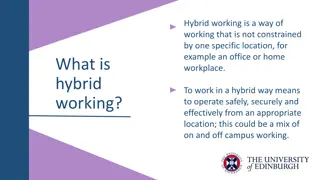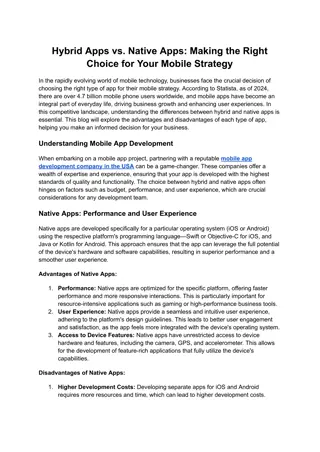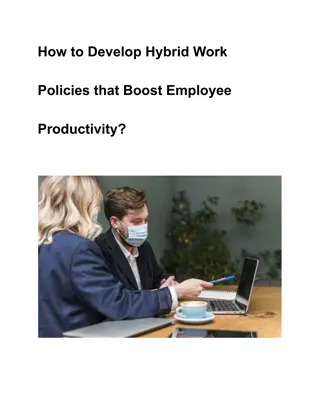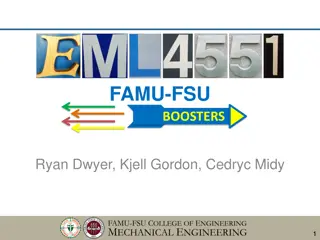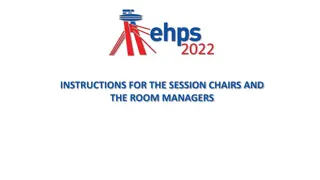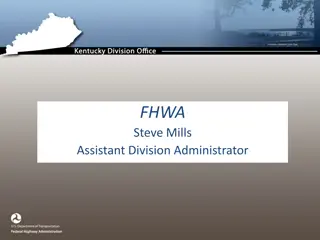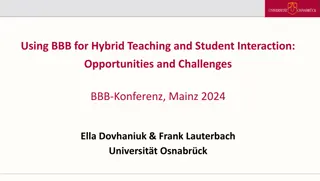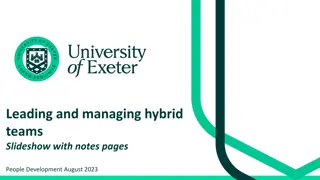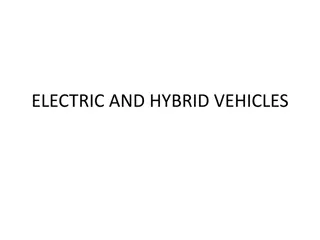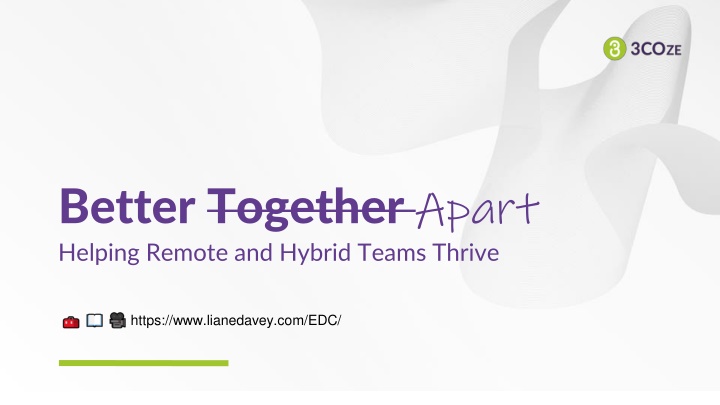
Building Trust in Remote and Hybrid Teams for Optimal Performance
Enhance productivity and collaboration in remote and hybrid teams by understanding the advantages and challenges of each work style. Discover the importance of building trust to overcome communication barriers and foster mutual knowledge among team members for improved performance.
Download Presentation

Please find below an Image/Link to download the presentation.
The content on the website is provided AS IS for your information and personal use only. It may not be sold, licensed, or shared on other websites without obtaining consent from the author. If you encounter any issues during the download, it is possible that the publisher has removed the file from their server.
You are allowed to download the files provided on this website for personal or commercial use, subject to the condition that they are used lawfully. All files are the property of their respective owners.
The content on the website is provided AS IS for your information and personal use only. It may not be sold, licensed, or shared on other websites without obtaining consent from the author.
E N D
Presentation Transcript
Better Together Apart Helping Remote and Hybrid Teams Thrive https://www.lianedavey.com/EDC/
Advantages of Each Work Style Benefits of Remote Work Enhanced productivity and quality Increased engagement and reduced absenteeism Reduced costs and environmental impact Greater flexibility and reduced lost-time Access to the best talent regardless of location Better disaster preparedness Benefits of Office Work Informal interactions Access to equipment for productivity Reduced distractions and interference from personal life Opportunity to play and celebrate Unintentional interactions Choudhury, P., Larson, B.Z., and Foroughi, C. (2019). Is it time to let employees work from anywhere? Harvard Business Review. https://hbr.org/2019/08/is-it-time-to-let- employees-work-from-anywhere
Challenges of Hybrid Teams 1. Trust is harder to build (and easier to destroy) virtually 2. Lack of context leads to unflattering judgments 3. Work is invisible and unseen work can lead to resentment 4. Virtual teams use written communication more, which leads to negativity bias 5. Absence of subtle cues prolongs conflict 6. Social friction reduces people s willingness to ask for help when they need it 7. Communication discrepancies create diverging paths
Trust Trust is harder to build (and easier to destroy) virtually
Building Trust Trust, the willingness to be vulnerable, is important to the effectiveness of all teams Teams with higher levels of trust are more productive, proactive, output focused The link between trust and performance is because of increase risk-taking Asking for help Sharing and asking for feedback Discussing conflicts and mistakes openly Abandoning need to control others The relationship between trust and performance is stronger in virtual/hybrid teams
Mutual Knowledge Mutual knowledge is the knowledge team members share, both content and context Having mutual knowledge is more difficult in virtual/hybrid teams because: Failure to share or remember contextual information Uneven distribution of information Differences in what is salient to the sender and receiver In the absence of shared content or context: Problems are attributed to skills or character Individuals fail to meet one another s expectations Trust erodes and performance suffers
Negativity Bias Written communication is susceptible to negativity bias
Information Richness Information richness is "the ability of information to change understanding within a time interval. Daft & Lengel Based on the capacity of the medium to transfer cues that help the receiver interpret meaning (gestures, pitch and tone, facial expressions, body language) Use rich media for novel, complex content Participants with little shared knowledge, experience, or language Discussions with tension or conflict Use lean media for routine issues or with people you know well
New Research-based Practices Increase use of audio plus content (screen sharing with no video) Equality of speaking, a predictor of collective intelligence, goes up on audio calls Increase use of phone calls Empathetic understanding is higher on phone calls Increase use of communication bursts (shared independent work time) Communication bursts create a collaborative experience across virtual teams Riedl, C. and Williams Woolley, A. (2020). Successful Remote Teams Communicate in Bursts. Harvard Business Review. https://hbr.org/2020/10/successful-remote-teams- communicate-in-bursts
Social Friction Social friction reduces willingness to ask for help
Increasing Capability and Confidence In virtual/hybrid teams, knowledge and skill gaps persist because of: Social concerns (reluctance to approach unfamiliar coworkers, fear of showing incompetence) Coordination difficulties (setting up time together) Search challenges (knowing whom to ask) Some employees avoid remote work for fear of missing out on social learning Virtual knowledge sharing is an approach to overcome the social friction of asking for help Sandvik, J. J., Saouma, R. E., Seegert, N. T., & Stanton, C. T. (2020). Workplace knowledge flows*. The Quarterly Journal of Economics, 135(3), 1635 1680. https://doi.org/10.1093/qje/qjaa013
Communication Discrepancies Communication discrepancies create diverging paths
Disparate Communication Managers who are in the office with some of their team are likely to communicate differently Office workers get more casual chatter, which is an advantage Office workers get the brunt of spontaneous tasks, which overwhelms them Remote workers miss opportunities and insights, which disadvantages them Be very aware and deliberate about what you share and with whom These discrepancies can lead to false perceptions of people and even to self-fulfilling prophecies that disadvantage remote team members
Off-task Time Off-task time is critically important to foster trust and make space for informal conversation that supports cohesiveness, problem-solving, and innovation. Meeting Time Water Cooler Time Take advantage of meeting time to build in space for off-task discussions Use a rolling start to your meetings and protect 5 minutes for casual chatter Encourage team members to leave their cameras on during breaks Protect 15-30 minutes of agenda-free time each week Recreate the spontaneous conversations that normally happen around the water cooler Set a virtual office hour each week where team members can drop in on you Have a weekly coffee hour or shared lunch time Use Yammer and Teams to share photos, articles, and other appropriate non-work related items 15
Communication is, by definition, not something you can accomplish on your own. You can't communicate to someone; you can only communicate with them.
Remote Management Reset These are the top 10 things you can do as a manager to reset to a more effective style of managing a remote or hybrid team
Thank You. Please connect with me on LinkedIn And find all the resources at https://www.lianedavey.com/EDC/






